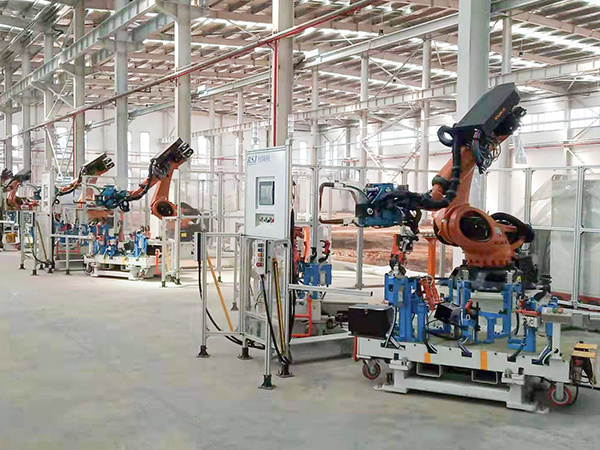荣仕杰为您介绍什么是点焊机器人,中间的环节和要注意的事项,以及使用细节在下文中我们做了详细的介绍。
在汽车生产过程中,点焊是一种重要的工艺,目前在产的镀锌板燃油车,车身有超过2000个焊点,有的车型焊点数甚至超过了5000。
点焊是一种高速、经济的连接方法,它适于制造可以采用搭接、接头不要求气密、厚度小于3mm的冲压、轧制的薄板构件。
点焊是把焊件在接头处接触面上的个别点焊接起来。
点焊要求金属有较好的塑性。
1、点焊的基础知识
点焊通常分为双面点焊和单面点焊两大类。
双面点焊时,电极由工件的两侧向焊接处馈电。典型的双面点焊方式是最常用的方式,这时工件的两侧均有电极压痕。大焊接面积的导电板做下电极,这样可以消除或减轻下面工件的压痕。
常用于装饰性面板的点焊。同时焊接两个或多个点焊的双面点焊,使用一个变压器而将各电极并联,这时,所有电流通路的阻抗必须基本相等,而且每一焊接部位的表面状态、材料厚度、电极压力都需相同,才能保证通过各个焊点的电流基本一致采用多个变压器的双面多点点焊。
点焊通常采用搭接接头和折边接头,接头可以由两个或两个以上等厚度或不等厚度的工件组成。
在设计点焊结构时,必须考虑电极的可达性,即电极必须能方便地抵达工件的焊接部位。同时还应考虑诸如边距、搭接量、点距、装配间隙和焊点强度诸因素。
边距的最小值取决于被焊金属的种类,厚度和焊接条件。对于屈服强度高的金属、薄件或采用强条件时可取较小值。
点距即相邻两点的中心距,其最小值与被焊金属的厚度、导电率,表面清洁度,以及熔核的直径有关。
规定点距最小值主要是考虑分流影响,采用强条件和大的电极压力时,点距可以适当减小。采用热膨胀监控或能够顺序改变各点电流的控制器时,以及能有效地补偿分流影响的其他装置时,点距可以不受限制。
装配间隙必须尽可能小,因为靠压力消除间隙将消耗一部分电极压力,使实际的焊接压力降低。间隙的不均匀性又将使焊接压力波动,从而引起各焊点强度的显著差异,过大的间隙还会引起严重飞溅,许用的间隙值取决于工件刚度和厚度,刚度、厚度越大,许用间隙越小,通常为0.1-2mm。
单个焊点的抗剪强度取决于两板交界上熔核的面积,为了保证接头强度,除熔核直径外,焊透率和压痕深度也应符合要求,焊透率的表达式为:η=h/δ-c×100%。两板上的焊透率只允许介于20-80%之间。
镁合金的最大焊透率只允许至60%。而钛合金则允许至90%。焊接不同厚度工件时,每一工件上的最小焊透率可为接头中薄件厚度的20%,压痕深度不应超过板件厚度的15%,如果两工件厚度比大于2:1,或在不易接近的部位施焊,以及在工件一侧使用平头电极时,压痕深度可增大到20-25%。
点焊接头受垂直面板方向的拉伸载荷时的强度,为正拉强度。由于在熔核周围两板间形成的尖角可引起应力集中,而使熔核的实际强度降低,因而点焊接头一般不这样加载。通常以正拉强度和抗剪强度之比作为判断接头延性的指标,此比值越大,则接头的延性越好。
多个焊点形成的接头强度还取决于点距和焊点分布。点距小时接头会因为分流而影响其强度,大的点距又会限制可安排的焊点数量。因此,必须兼顾点距和焊点数量,才能获得最大的接头强度,多列焊点最好交错排列而不要作矩形排列。
焊接保证需要强度的地方焊接的间距会比较近,但是考虑到可能会出现的电焊分流的情况,焊点布置的时候应考虑其焊接不牢固性,所以并不是越近越多越好,合理布置焊点才能得到更好的效果,一般来说,三层焊焊点比两层焊焊点的间距稍远一点。
焊点的施加原则一般不超过5mm,焊接板厚比例不超过1:3,超过这个值会造成焊核不在焊点最中心,甚至焊穿薄板的可能。三层焊焊接最厚跟最薄也不能超过1:3的原则。
焊点的多少应以连接强度是否满足需要为标准,过多、过密的焊点只能增加焊接的成本,同时过密的焊点由于焊接分流的加大,焊接强度降低。
焊点位置是工艺和产品设计协调的结果重要焊点位置应以CAE计算结果来设定,下表为不同料厚焊点剪切强度要求:
焊接时,先把焊件表面清理干净,再把被焊的板料搭接装配好,压在两柱状铜电极之间,施加压力P压紧,当通过足够大的电流时,在板的接触处产生大量的电阻热,将中心最热区域的金属很快加热至高塑性或熔化状态,形成一个透镜形的液态熔池。继续保持压力P,断开电流,金属冷却后,形成了一个焊点。镀锌钢板大致分为电镀锌钢板和热浸镀锌钢板,前者的镀层比后者薄。
点焊镀锌钢板用的电极,推荐用2类电极合金。相对点焊外观要求很高时,可以采用1类合金。推荐使用锥形电极形状,锥角120度-140度。
使用焊钳时,推荐采用端面半径为25-50mm的球面电极。为提高电极使用寿命,也可采用嵌有钨极电极头的复合电极,以2类电极合金制成的电极体,可以加强钨电极头的散热。
通常是根据工件的材料和厚度,参考该种材料的焊接条件表选取,首先确定电极的端面形状和尺寸。其次初步选定电极压力和焊接时间,然后调节焊接电流,以不同的电流焊接试样,经检查熔核直径符合要求后,再在适当的范围内调节电极压力,焊接时间和电流,进行试样的焊接和检验,直到焊点质量完全符合技术条件所规定的要求为止。
最常用的检验试样的方法是撕开法,优质焊点的标志是:在撕开试样的一片上有圆孔,另一片上有圆凸台。厚板或淬火材料有时不能撕出圆孔和凸台,但可通过剪切的断口判断熔核的直径。必要时,还需进行低倍测量、拉抻试验和X光检验,以判定熔透率、抗剪强度和有无缩孔、裂纹等。以试样选择工艺参数时,要充分考虑试样和工件在分流、铁磁性物质影响,以及装配间隙方面的差异,并适当加以调整。
焊点直径的量取由长轴测量数值加上与长轴垂直轴测量值除2来计算,d=(a+b)/2
铝合金的点焊
铝合金的应用十分广泛,分为冷作强化和热处理强化两大类。铝合金点焊的焊接性较差,尤其是热处理强化的铝合金。其原因及应采取的工艺措施如下:
(1)电导率和热导率较高必须采用较大电流和较短时间,才能做到既有足够的热量形成熔核;又能减少表面过热、避免电极粘附和电极铜离子向纯铝包复层扩散、降低接头的抗腐蚀性。
(2)塑性温度范围窄、线膨胀系数大 必须采用较大的电极压力,电极随动性好,才能避免熔核凝固时,因过大的内容拉应力而引起的裂纹。对裂纹倾向大的铝合金,如LF6、LY12、LC4等,还必须采用加大锻压力的方法,使熔核凝固时有足够的塑性变形、减少拉应力,以避免裂纹产生。在弯电极难以承受大的定锻压力时,也可以采用在焊接脉冲之后加缓冷脉冲的方法避免裂纹。对于大厚度的铝合金可以两种方法并用。
(3)表面易生成氧化膜,焊前必须严格清理,否则极易引起飞溅和熔核成形不良(撕开检查时,熔核形状不规则,凸台和孔不呈圆形),使焊点强度降低。清理不均匀则将引起焊点强度不稳定。
基于上述原因,点焊铝合金应选用具有下列特性的焊机:
1)能在短时间内提供大电流
2)电流波形最好有缓升缓降的特点
3)能精确控制工艺参数,且不受电网电压波动影响
4)能提供价形和马鞍形电极压力
5)机头的惯性和摩擦力小,电极随动性好。
当前国内使用的多为300-600KVA的直流脉冲、三相低频和次级整流焊机,个别的达到1000KVA,均具有上述特性。也有采用单相交流焊机的,但仅限于不重要工件。
点焊铝合金的电极应采用1类电极合金,球形端面,以利于压固熔核和散热。
由于电流密度大和氧化膜的存在,铝合金点焊时,很容易产生电极粘着。电极粘着不仅影响外观质量,还会因电流减小而降低接头强度。为此需经常修整电极。电极每修整依次后可焊工件的点数与焊接条件、被焊金属型号、清理情况、有无电流波形调制,电极材料及其冷却情况等因素有关。通常点焊纯铝为5-10点,点焊LF6,LY12时为25-30点。
防透铝LF21强度低,延性后,有较好的焊接性,不产生裂纹,通常采用固定不变电极压力。硬铝(如LY11、LY12),超硬铝(如LC4、LC5)强度高、延性差,极易产生裂纹,必须采价形曲线的压力。但对于薄件,采用大的焊接压力或具有缓冷脉冲的双脉冲加热,裂纹也不是不可避免的。
采用价形压力时,锻压力滞后于断电的时刻十分重要,通常是0-2周。锻压力加得过早(断电前),等于增大了焊接压力,将影响加热,导致焊点强度降低和波动。锻压力加得过迟,则熔核冷却结晶时已经形成裂纹,加锻压力已无济于事。有时也需要提前于断电时刻施加锻压力,这是因为电磁气阀动作延迟,或气路不畅通造成锻压力提高缓慢,不提前施加不足以防止裂纹的缘故。
2、点焊机器人系统
(1)机器人本体
(2)伺服/气动点焊钳
(3)电极修磨器
(4)管线包
(5)焊钳控制电缆
(6)水气单元
(7)焊钳冷水管
(8)焊钳回水管
(9)点焊控制器冷水管(空冷不需要)
(10)冷水机
(11)点焊控制器
(12)机器人变压器
(13)焊接电缆
(14)机器人控制器
(15)焊接控制器通讯线缆
(16) (17) (18)机器人线缆
(19)伺服编码器线缆
(20)机器人示教器
(21)冷却水开关
(22)供电电源
根据白车身点焊焊钳负载及臂展的统计,一般要求选择的机器人负载在180KG以上,臂展在2.5M以上就能满足大部分点焊工位的要求,如果有换枪盘或内置管线包,则负载相应加大20KG。
焊接控制器分为工频和中频两种,焊接控制器有以下功能:
1、通过初级和次级闭环实现电流的精确控制,控制精度超越普通的同类产品,可有效避免焊点虚焊、焊穿等缺陷。
2、焊点计数器功能,有效防止漏焊,并可自动进行电极修磨及电极寿命维护,保证焊点直径。
3、独立监控焊核成长,并独立补偿实际焊核与要求焊核的变化。
4、确保每个焊点直径。
5、自动补偿焊接扰动。
6、焊接过程中焊接时间和电流自适应变化。
7、在线储存测量数据及曲线。
中频焊接控制器变压器更小更轻,能提供持续高能量,电流调整更快更精确,可应用于:镀锌板、高强度钢板、铝合金板、3层板焊接及大喉宽焊钳。
拥有紧凑的脉冲形式,没有感应损耗,小于1毫秒的调整,没有电流峰值,没有多余的冷却时间,从而提供更高的能量,减少电极的热量和机械压力。中频相较于工频电极寿命增加30 – 50%并提供20 – 32 % 的节能。
此外,中频焊接控制器还有以下特点:焊接参数的精确调整(动态调整和自适应的调整);没有材料过热(较少的飞溅)。
点焊钳:用于实现对焊接的工件(板材)的加压。机器人使用的焊钳通常是变压器与钳体安装在一起,成为一个整体,称为“一体式焊钳”。在实际应用中,需要根据打点位置的特殊性,对焊钳钳体须做特殊的设计,只有这样才能确保焊钳到达焊点位置。
机器人点焊钳必须与点焊工件所要求的焊接规范相适应,基本原则是:
1、根据工件的材质和板厚,确定焊钳电极的最大短路电流和最大加压力;
2、根据工件的形状和焊点在工件上的位置,确定焊钳钳体的喉深、喉宽、电极握杆、最大行程、工作行程等;
3、综合工件上所有焊点的位置分布情况,确定选择何种焊钳,通常有四种焊钳比较普遍,即:C型单行程焊钳、C型双行程焊钳、X型单行程焊钳、X型双行程焊钳;
4、在满足以上条件的情况下,尽可能地减小焊钳的重量。
伺服焊钳相较气动焊钳的优势:
1、机器人与焊钳同步协调运动,大大提高生产节拍
2、焊接中压力与热量同步增长,更可靠保证焊点质量
3、扩展工艺过程控制
4、增强诊断及监控
5、简化焊钳设计,提高柔性
6、降低维修率,提高运行时间
7、减少生产成本(耗气,备件)
8、一个焊接循环后自动调整电极帽零位
9、换枪后检查/调整焊钳,在断开伺服控制时焊钳臂位移后可进行修正焊钳零位
减少生产节拍体现在:
1、使焊点间及障碍物的跳转路径最小化。
2、可随意缩短电极开口减小关闭焊钳时间。
3、焊接开始信号发出后可更快更好的控制加压。
4、焊接完成信号发出后可更快打开焊钳。
5、更快的更改焊接压力。
6、减小电极更换及修磨时间。
7、换枪、电极修磨及更换后快速标定。
提高焊接质量体现在:
1、软接触可实现极少的产品冲击
2、高精确度的可重复性加压
3、焊接中精确恒压控制
4、更稳定的电极管理及控制
增强诊断及监控体现在:
1、压力监控,防止压痕过深、焊点裂纹现象
2、电极帽诊断,监控电极磨损
3、电极修磨器状况
4、多层板的联结状态
5、换枪及急停后的位置诊断
简化焊钳设计,提高柔性:
1、焊接压力范围增大
2、无大开口及小开口限制,优化焊钳臂定位
3、不同工作站利用同一个焊钳设计,减少数量
4、电机集成化,减小焊钳质量
5、其高柔性便于在项目前期确定焊钳设计
降低维修率,提高运行时间体现在:
1、更容易进行错误追踪
2.诊断及预防性保养
3、减少备件数量
4、排除平衡问题
减少生产成本体现在:
1、耗气量
2、电机帽消耗
3、电机杆消耗
4、维修费用
5、易于编程
伺服点焊平衡补偿技术
机械平衡

软件平衡

焊接位置修正:允许编程误差+/-3mm
释放固定焊钳臂:可释放固定焊钳臂5mm
焊钳臂偏差补偿:可补偿焊钳臂偏差5mm
电极帽测量及补偿 :测量电极帽并可补偿0-10mm 金属板的位置+/- 1 mm
水气单元:
电极修磨器:
通常在点焊生产时,电极上通过的电流密度很大,再加上同时作用的比较大的加压力,电极极易失去其原有的形状,这样对焊核的大小就不能很好的控制;同时由于电极的导电面的氧化造成导电能力下降,点焊时通电电流值就不能得到很好的保证。为了消除这些不利因素对焊接质量的影响,必须使用电极修磨机定期对电极进行修磨。
管线包:
机器人管线包主要是用于连接机器人终端执行器(换枪盘,焊钳等)应用而开发的一套线束系统;该线束具备以下几种特点:
1、满足设备的应用功能
2、具有较好的使用寿命
3、尽量不限制机器人的工作范围
4、便于安装和维修
以下是标准伺服点焊线缆包的联接方式:
最后我们分享几个标准点焊工作站的平面布置图,并欣赏一段机器人点焊自动化视频(请点击首页观看视频):
6, reduce electrode replacement and grinding
日文
Rong Shijieが、スポット溶接ロボットとは何か、中間リンク、注意すべき事項、および使用の詳細を紹介します。詳細については、以下で説明します。
自動車の生産工程では、スポット溶接が重要なプロセスであり、現在、亜鉛めっきシート燃料トラックには2000以上のはんだ接合部があり、一部のモデルでは5,000以上のはんだ接合部さえあります。
スポット溶接は、ラップジョイント、気密性を必要としないジョイント、および3 mm未満の厚さを使用してプレスおよび圧延できる板金部品の製造に適した高速で経済的な接合方法です。
スポット溶接は、接合部の接触面上の溶接物の個々のポイントの溶接です。
スポット溶接では、金属の塑性が良好である必要があります。
1、スポット溶接の基礎知識
スポット溶接は、通常、両面スポット溶接と片面スポット溶接の2つのカテゴリに分けられます。
両面スポット溶接では、電極はワークの側面から溶接部に送られます。典型的な両面スポット溶接法は、最も一般的な方法です。この場合、ワークピースの両側に電極くぼみがあります。広いはんだ付け領域の導電性プレートは下部電極として使用されます。これにより、下のワークピースのくぼみを除去または削減できます。
一般的に装飾パネルのスポット溶接に使用されます。トランスを使用して電極を並列に接続し、両面スポット溶接用に2つ以上のスポット溶接を同時に溶接します。このとき、すべての電流経路のインピーダンスは実質的に等しく、各溶接部分の表面状態、材料の厚さ、電極圧力が等しくなければなりません。複数の変圧器の両面多点スポット溶接を使用して、各はんだ接合部を流れる電流が基本的に同じになるように、すべてが同じである必要があります。
スポット溶接では通常、ラップジョイントとフランジジョイントを使用します。これらは、同じまたは異なる厚さの2つ以上のワークピースで構成できます。
スポット溶接構造を設計するとき、電極のアクセシビリティを考慮する必要があります。つまり、電極がワークピースの溶接部分に簡単に到達できる必要があります。マージン、ラップジョイント、ドットピッチ、アセンブリギャップ、はんだ接合強度などの要因も考慮する必要があります。
最小マージンは、はんだ付けする金属の種類、厚さ、はんだ付け条件によって異なります。降伏強度の高い金属、薄い部品、または強い条件を使用する場合は、より小さな値が得られる場合があります。
ポイント距離は、隣接する2つのポイント間の中心距離であり、最小値は、溶接する金属の厚さ、導電率、表面の清浄度、およびナゲットの直径に関連しています。
指定点距離の最小値は、主に分割の影響を考慮したものであり、強い条件と大きな電極圧力を使用すると、ドットピッチを適切に縮小できます。熱膨張監視または各ポイントで電流を連続的に変更できるコントローラー、およびシャントの影響を効果的に補償できる他のデバイスを使用する場合、ドットピッチは無制限にできます。
ギャップによる圧力を解放すると、電極圧力の一部が消費され、実際の溶接圧力が低下するため、アセンブリのクリアランスはできるだけ小さくする必要があります。ギャップの不均一性により、溶接圧力が変動し、各はんだ接合の強度に大きな差が生じます。ギャップが大きすぎると、スプラッシュが激しくなります。許容ギャップ値は、ワークの剛性と厚さに依存し、剛性と厚さは大きくなります。許容されるギャップが小さいほど、通常0.1〜2 mmです。
単一のはんだ接合のせん断強度は、2つのプレートの接合部におけるナゲットの面積に依存し、接合強度を確保するために、ナゲットの直径に加えて、浸透速度と押込み深さも要件を満たす必要があります。浸透速度の表現は次のとおりです。 = h /δ-c×100%。両方のボードの普及率は、20〜80%の間でのみ許可されています。
マグネシウム合金の最大浸透率は60%のみです。チタン合金は90%まで許可されています。異なる厚さのワークピースを溶接する場合、各ワークピースの最小貫通率は接合部の薄い部分の厚さの20%になることがあり、2つのワークピースの厚さ比が2:1を超える場合、押込み深さはシートの厚さの15%を超えてはなりません溶接がアクセスできない領域に適用され、ワークピースの片側に平らな電極が使用されている場合、くぼみの深さを20〜25%に増やすことができます。
垂直パネルの方向に引張荷重をかけたときのスポット溶接継手の強度は、正の引張強度です。ナゲットの周囲の2つのプレートの間に形成された鋭い角は応力集中を引き起こす可能性があり、ナゲットの実際の強度が低下するため、スポット溶接継手は一般にそのように負荷されません。一般に、引張強度とせん断強度の比は、接合部の延性を判断する指標として使用され、比が大きいほど、接合部の延性が向上します。
複数のはんだ接合によって形成される接合強度は、ピッチとはんだ接合の分布にも依存します。点と時間の接合部は、分割のために強度に影響し、その結果、配置できる溶接の数が制限されます。したがって、最大の接合強度を得るために、ドットピッチとはんだ接合の数のバランスを取る必要があり、多列はんだ接合は、長方形に配置するよりも千鳥配置することが好ましい。
強度を確保するために溶接が必要な場合、溶接の間隔は比較的近くなりますが、溶接のシャントの可能性を考慮して、溶接が強くない場合は溶接点を考慮すべきであるため、可能な限り近く、合理的な配置ではありません一般的に言えば、3層はんだ接合は2層はんだ接合よりもわずかに遠くなります。
はんだ接合の適用の原則は一般に5mm以下であり、溶接板の厚さの比率は1:3以下です。この値を超えると、溶接ナゲットがはんだ接合の中心になく、薄い板を貫通することさえありません。最も厚くて薄い3層溶接は、1:3の原則を超えることはできません。
はんだ接合部の数は、接合強度が要件を満たしているかどうかに基づいて決定する必要があります。はんだ接合部が多すぎると、はんだ付けのコストが増加するだけです。同時に、はんだ接合部のシャントが増加するため、はんだ接合強度が低下します。
はんだ接合部の位置は、プロセスと製品設計の調整の結果です。重要なはんだ接合部の位置は、CAEの計算結果によって設定する必要があります。
溶接時には、溶接物の表面が最初に洗浄され、次に溶接プレートがラップされて組み立てられ、2つの円柱状の銅電極の間で押され、圧力Pで押されます。十分な電流が流れると、プレートの接点大量の抵抗熱が発生し、中心部の最も熱い領域の金属が急速に加熱されて高度に可塑性または溶融状態になり、レンチキュラー液体溶融プールが形成されます。圧力Pを維持し続け、電流を切断し、金属が冷却した後、はんだ接合部を形成します。亜鉛めっき鋼板は、電気亜鉛めっき鋼板と溶融亜鉛めっき鋼板に大別され、前者は後者よりも薄い。
亜鉛メッキ鋼板のスポット溶接用電極には、2種類の電極合金を使用することをお勧めします。クラス1合金は、スポット溶接の外観が高い場合に使用できます。 120〜140度のテーパー角を持つテーパー電極形状を使用することをお勧めします。
溶接トングを使用する場合は、面半径が25〜50mmの球状電極を使用することをお勧めします。電極の耐用年数を改善するために、タングステン電極チップが埋め込まれた複合電極を使用でき、タイプ2電極合金で作られた電極本体はタングステン電極チップの熱放散を強化できます。
通常、ワークの材質と厚さに応じて、材質の溶接条件表を参照して、電極の端面の形状とサイズを最初に決定します。次に、電極圧力と溶接時間を事前に選択し、溶接電流を調整し、サンプルを異なる電流で溶接します。ナゲットの直径が要件を満たしていることを確認した後、電極圧力、溶接時間、電流を適切な範囲内で調整してサンプルを実行します。はんだ接合部の品質が技術条件で指定された要件を完全に満たすまでの溶接と検査。
高品質のはんだ接合部のマーキングは、引き裂かれたサンプルの片方に丸い穴があり、もう片方に丸いボスがあります。厚いプレートまたは急冷された材料は、丸い穴やボスを引き裂くことができない場合がありますが、ナゲットの直径はせん断破壊によって判断できます。必要に応じて、貫通率、せん断強度、および収縮空洞、亀裂などの有無を判断するために、低電力測定、引張試験、およびX線試験も必要です。サンプルのプロセスパラメータを選択するときは、サンプルとシャント内のワークピースの差、強磁性体の影響、およびアセンブリギャップを十分に考慮し、適切に調整する必要があります。
はんだ接合部の直径は、長軸の測定値と長軸の垂直軸の測定値を除算して計算され、d =(a + b)/ 2
アルミニウム合金のスポット溶接
アルミニウム合金の用途は非常に広範囲であり、冷間加工強化と熱処理強化の2つのカテゴリに分類されます。アルミニウム合金のスポット溶接の溶接性は、特に熱処理されたアルミニウム合金では劣っています。この理由と取るべき技術的対策は次のとおりです。
(1)より高い伝導率と熱伝導率は、ナゲットを形成するのに十分な熱を達成するためにより大きな電流とより短い時間を使用する必要があります;表面の過熱を減らし、電極の付着と電極銅イオンを純アルミニウムに避けますコーティング層は拡散し、接合部の耐食性を低下させます。
(2)塑性温度範囲が狭く、線膨張係数が大きい。ナゲットが固化するときの過度の引張応力による亀裂を避けるために、大きな電極圧力を使用する必要があり、電極の追従性が良い。 LF6、LY12、LC4などの大きな亀裂傾向のあるアルミニウム合金の場合、鍛造圧力を高めてナゲットに十分な塑性変形を与え、引張応力を低下させて亀裂を回避する必要があります。湾曲した電極が大きな鍛造圧力に耐えることが困難な場合、割れを避けるために溶接パルスの後に遅いパルスを追加する方法を使用することも可能です。厚いアルミニウム合金の場合、2つの方法を併用できます。
(3)表面は酸化膜を形成しやすいので、溶接前に洗浄する必要があります。そうしないと、スプラッシュとナゲットの形成が容易になります(引き裂きをチェックすると、ナゲットの形状が不規則で、ボスと穴が丸くない)、はんだ接合部強度が低下します。不均一な洗浄は、はんだ接合強度を不安定にします。
上記の理由により、アルミニウム合金のスポット溶接では、次の特性を持つ溶接機を使用する必要があります。
1)短時間で大電流を供給できる
2)電流波形は、立ち上がりと立ち下がりが遅いことが特徴です。
3)グリッド電圧変動の影響を受けないプロセスパラメータの正確な制御
4)形状とサドル電極圧力を提供できる
5)頭部の慣性と摩擦が小さく、電極追従性が良い。
現在、国内で使用されている300-600KVA DCパルス、三相低周波および二次整流溶接機のほとんどは、それぞれ最大1000KVAまで、上記の特性を備えています。単相AC溶接機も使用されますが、重要でないワークピース専用です。
スポット溶接されたアルミニウム合金の電極は、ナゲットの凝固と熱放散を促進するために、球状の端面を持つタイプ1電極合金でなければなりません。
電流密度が大きく、酸化膜が存在するため、アルミニウム合金のスポット溶接中に電極の固着が発生しやすくなります。電極の付着は外観の品質に影響するだけでなく、電流の減少により接合強度も低下します。これを行うには、電極を頻繁にトリミングする必要があります。電極の各トリミング後に溶接できるポイントの数は、溶接条件、溶接する金属の種類、洗浄条件、電流波形変調の有無、電極材料およびその冷却条件に関連しています。通常、純アルミニウムのスポット溶接は5-10ポイント、LF6のスポット溶接、LY12は25-30ポイントです。
透明でないアルミニウムLF21は、強度が低く、延性後の延性が良好で、割れがなく、通常は一定の電極圧力を使用します。硬質アルミニウム(LY11、LY12など)、超硬質アルミニウム(LC4、LC5など)は、強度が高く、延性が低く、割れやすい傾向があります。価格曲線の圧力を取る必要があります。ただし、大きな溶接圧力または遅い冷却パルスを使用したダブルパルス加熱を使用する薄い部品の場合、亀裂は避けられません。
原子価圧力を使用する場合、鍛造圧力が停電の瞬間、通常0〜2週間より遅れることが重要です。鍛造圧力が早すぎる(停電前)ために加えられます。これは、溶接圧力を上げることに相当し、加熱に影響し、はんだ接合強度の低下と変動をもたらします。鍛造圧力を加えるのが遅すぎると、ナゲットの冷却中に亀裂が形成され、鍛造圧力は役に立たなかった。停電時に事前に鍛造圧力をかける必要がある場合があります。これは、電磁弁の動作が遅れているか、ガス通路のスムーズでない通過のために鍛造圧力が遅く、亀裂を防ぐために事前に加えられないためです。
2、スポット溶接ロボットシステム
(1)ロボット本体
(2)サーボ/空気圧スポット溶接トング
(3)電極ドレッサー
(4)パイプラインパッケージ
(5)溶接トング制御ケーブル
(6)水とガスのユニット
(7)溶接トング冷水パイプ
(8)溶接クランプ戻り管
(9)スポット溶接コントローラーの冷水パイプ(空冷には不要)
(10)チラー
(11)スポット溶接コントローラー
(12)ロボットトランス
(13)溶接ケーブル
(14)ロボットコントローラー
(15)溶接コントローラー通信ケーブル
(16)(17)(18)ロボットケーブル
(19)サーボエンコーダケーブル
(20)ロボットティーチペンダント
(21)冷却水スイッチ
(22)電源
ホワイトボディのスポット溶接トングの負荷とアームスパンの統計情報によれば、選択されたロボットの負荷は180KGを超えることが一般に必要であり、2.5M以上のアームスパンは、交換ガンまたは組み込みのパイプラインパッケージがある場合、ほとんどのスポット溶接ステーションの要件を満たすことができます。 、それに応じて負荷が20KG増加します。
溶接コントローラーは、電源周波数と中周波数の2つのタイプに分けられ、溶接コントローラーには次の機能があります。
1.一次および二次閉ループにより、電流の正確な制御を実現し、制御精度は通常の類似製品を上回り、はんだ接合、はんだ付け、はんだ付けなどの欠陥を効果的に回避できます。
2、はんだ接合カウンター機能、効果的に漏れ溶接を防ぎ、はんだ接合の直径を確保するために、自動的に電極研削と電極寿命のメンテナンスを行うことができます。
3.溶接ナゲットの成長を独立して監視し、実際の溶接ナゲットと必要な溶接ナゲットの変化を独立して補正します。
4.各はんだ接合部の直径を確認します。
5.溶接障害を自動的に補正します。
6.溶接中の溶接時間と電流の適応的な変更。
7.測定データと曲線をオンラインで保存します。
IF溶接コントローラートランスは小型軽量で、連続的な高エネルギーを供給でき、電流調整はより高速でより正確です。亜鉛メッキシート、高強度鋼板、アルミニウム合金シート、3層板溶接、スロート幅の広い溶接トングに適用できます。
コンパクトなパルス形状、誘導損失、1ミリ秒未満の調整、電流ピーク、余分な冷却時間はなく、より高いエネルギーを提供し、電極の熱と機械的ストレスを軽減します。 IFは電源周波数電極より30〜50%長く、20〜32%のエネルギーを節約します。
さらに、IF溶接コントローラーには次の機能があります:溶接パラメーターの正確な調整(動的調整と適応調整);材料の過熱なし(スパッターが少ない)。
スポット溶接トング:溶接されたワークピース(プレート)を加圧するために使用されます。ロボットが使用する溶接トングは、通常、「統合溶接トング」と呼ばれる、全体として一緒に取り付けられた変圧器とトングです。実際のアプリケーションでは、溶接トングが溶接ポイントの位置に確実に到達するように、スポッティングの位置の特殊性に従って溶接トングの特別な設計を行う必要があります。
ロボットスポット溶接トングは、スポット溶接ワークピースに必要な溶接仕様に適合させる必要があります。
1.ワークピースの材料と厚さに応じて、溶接トングの電極の最大短絡電流と最大押圧力を決定します。
2.ワークピースの形状とワークピース上のはんだ接合部の位置に応じて、溶接トングのスロート深さ、スロート幅、電極グリップ、最大ストローク、作業ストロークなどを決定します。
3、統合されたワークピース上のすべてのはんだ接合の位置分布は、選択する溶接トングの種類を決定し、通常4種類の溶接トングがより一般的です、すなわち:Cタイプシングルストローク溶接トング、Cタイプダブルストローク溶接トング、Xタイプシングルストローク溶接プライヤー、X型ダブルストローク溶接トング;
4.上記の条件下で、溶接トングの重量をできるだけ減らします。
空気圧溶接トングと比較したサーボ溶接トングの利点:
1.ロボットと溶接トングが同期して動作を調整し、生産サイクルを大幅に改善します。
2.溶接の圧力と熱は同時に増加し、はんだ接合の品質はより信頼性が高くなります。
3、プロセス制御を拡大
4、診断と監視を強化する
5、溶接トングの設計を簡素化し、柔軟性を向上させる
6、メンテナンス率を削減し、実行時間を改善
7、生産コストを削減(ガス消費、スペアパーツ)
8、溶接サイクル後に自動的に電極キャップゼロを調整します
9.ガンを交換した後、溶接トングを確認/調整し、サーボ制御が切断されたときに溶接トングが移動した後、溶接トングのゼロ位置を修正します。
生産ビートの削減は、以下に反映されます。
1.はんだ接合部と障害物の間のジャンプパスを最小限にします。
2.電極の開口部を自由に短くして、溶接トングを閉じる時間を短縮できます。
3.溶接開始信号が送信された後、加圧をより速く、より良く制御できます。
4.溶接完了信号が発行された後、溶接トングをより速く開くことができます。
5.溶接圧力をより速く変更します。
6、電極の交換と研削を削減



咨询热线
400-693-3363